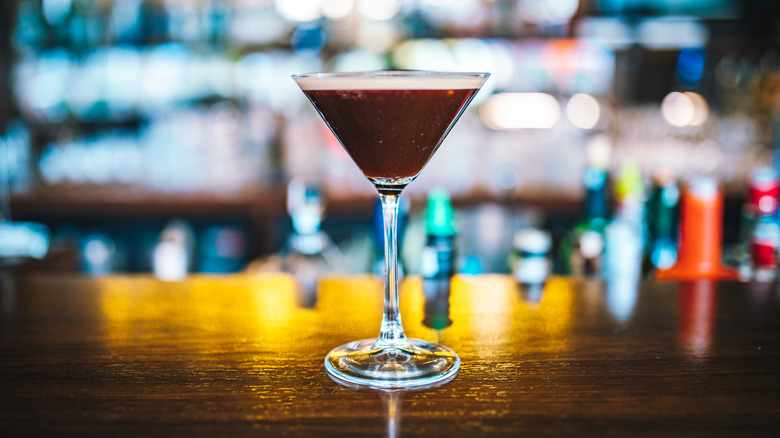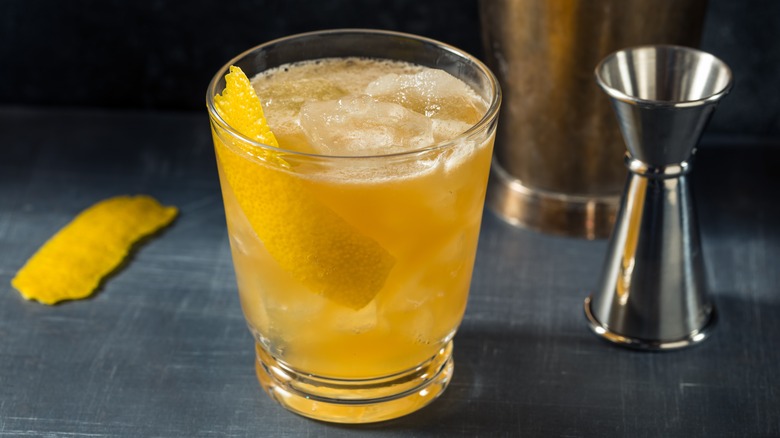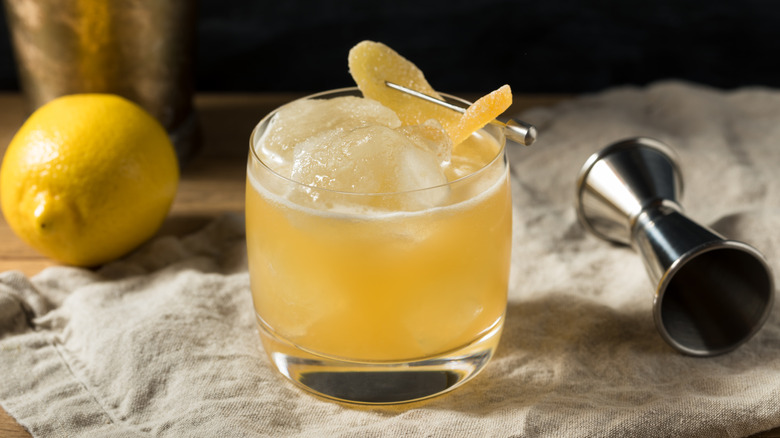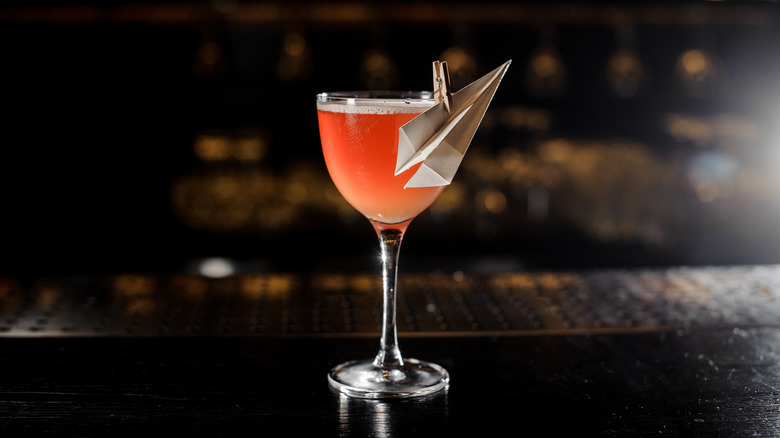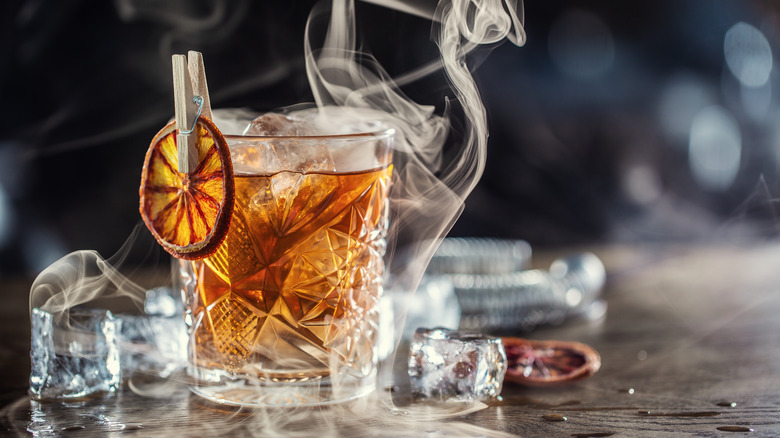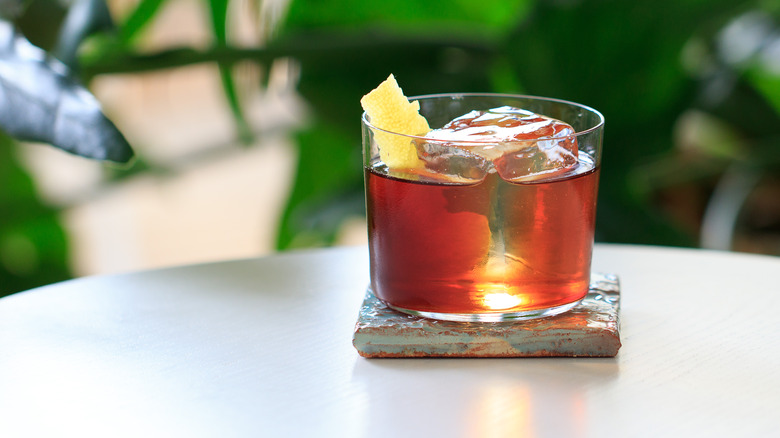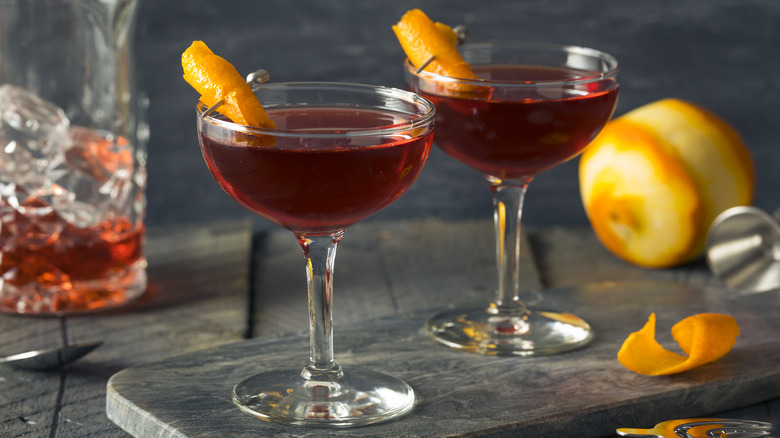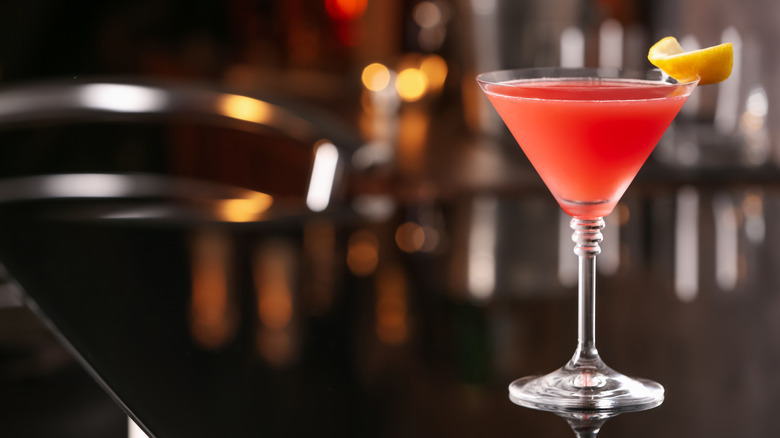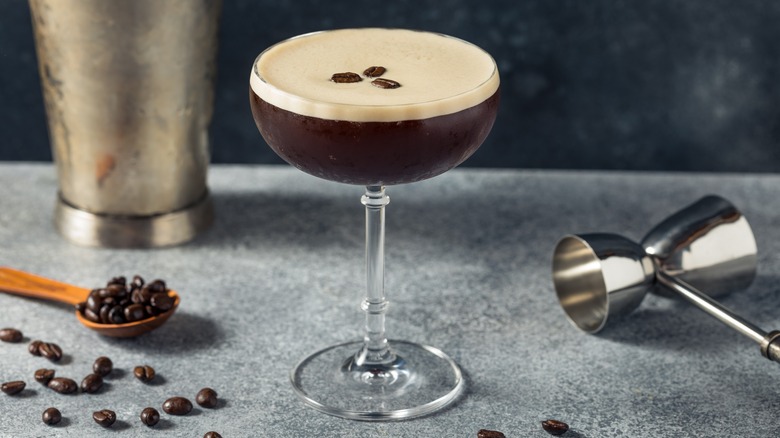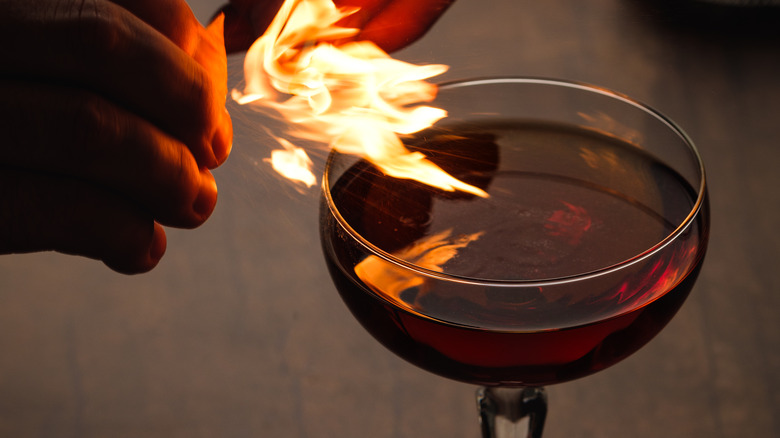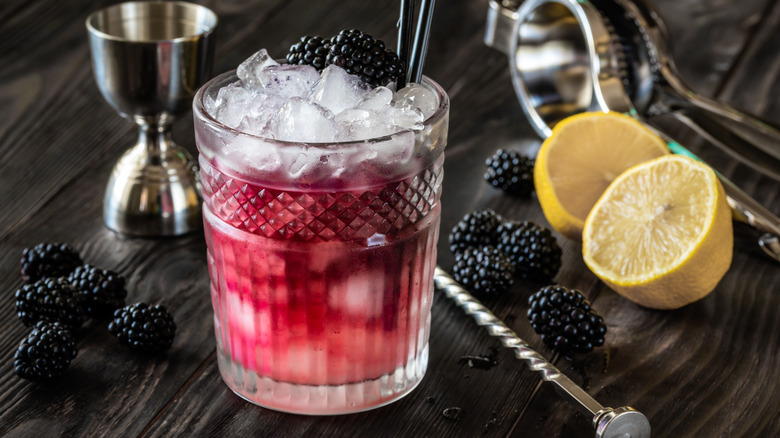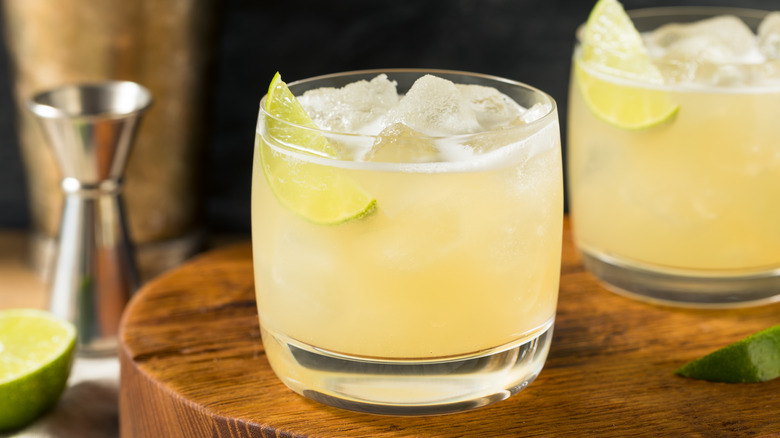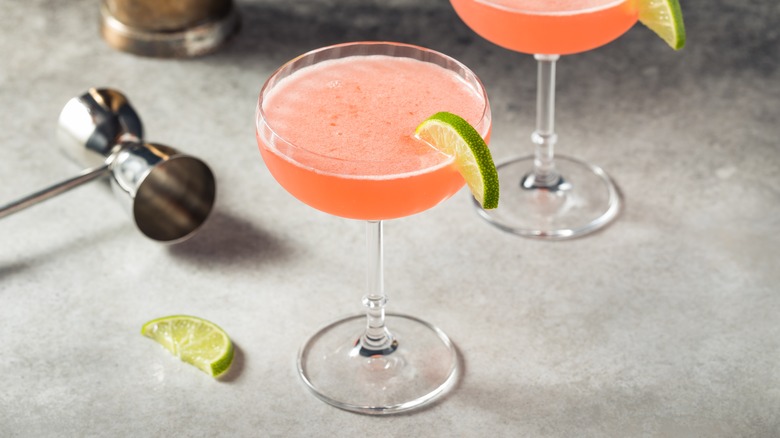The 12 Best Modern Classic Cocktails
Before Prohibition, cocktail culture in the United States was thriving. So many mixed drinks still popular today were born around the turn of the century, but the creativity of bartenders did not stop in the 1920s, according to Smithsonian Magazine. In fact, it flourished. With spirits like bathtub gin being the only ones available, bartenders had to get creative with their mixology to mask the bad tastes.
Luckily, in the 1980s, bartenders sought to revitalize the bar scene and recapture that creative spirit by inventing new drinks, reinventing old ones, and even revising those reinventions. This was the start of the cocktail renaissance, which continues to thrive today. Craft cocktail lounges are more prevalent than ever, and bartenders are doing their best to bring exotic and unfamiliar ingredients to expand their customers' palates.
This mixology revolution has spawned countless revelations that have cemented themselves as menu mainstays for the foreseeable future. Here are the most notable modern classic cocktails.
Gold Rush
The Gold Rush was invented at the iconic Milk and Honey bar in New York City and is one of the establishment's first of many modern classics. It was born in the 2000s by T.J. Siegal, who actually created the drink as a customer, not a bartender, per Punch. At the time, Milk and Honey's owner, Sasha Petraske, was experimenting with different syrups, one of which was a honey syrup. His childhood friend, Siegal, entered the establishment and requested his usual whiskey sour. Petraske explained to his friend what he was working on, and when he mentioned the honey syrup, Siegal was curious, so he asked for it to be used in his cocktail as a substitute for the simple syrup. The result was the Gold Rush, an instant hit that soon became a staple.
Although the updated cocktail is a direct riff on the whiskey sour, it can also be likened to a bourbon Bee's Knees or a chilled Hot Toddy (via Money Inc). This is what makes this drink so widely beloved and a great example of a modern cocktail. It can remind you of reliable and timeless predecessors but can thrive by its own unique character. The best part is you can easily make a Gold Rush at home by making an easy honey syrup using three parts honey and one part hot water. All that remains is bourbon and lemon juice, and you have yourself this modern classic.
Penicillin
The Penicillin cocktail is the utmost embodiment of what the modern mixed drink boom is all about. It's resourceful, innovative, complex, and nuanced, yet remains straightforward and classic-tasting. The beverage is credited to one of the most important and impactful bartenders of the cocktail renaissance, Sam Ross (via VinePair).
This particular creation came about in 2005 as a riff on the Gold Rush. During a quiet shift, Ross was experimenting with the whiskey sour variation and decided to play with the sweetener. In addition to the honey syrup, Ross used ginger syrup. From there, he replaced the bourbon with blended scotch whisky, and after shaking and straining over ice, a smaller amount of Islay scotch was added on top, and the Penicillin was born.
The cocktail's name comes from the ginger and honey, two ingredients inherently comforting when you feel under the weather. The flavors naturally complement the maltiness of both scotches used but work especially well with the peat and smoke of the Islay scotch. The lemon juice remains to keep the drink sharp and vibrant, making it as balanced and complex as a cocktail can be. The Penicillin is spicy, smoky, tart, and sweet and has proven to be a timeless cocktail that has cemented itself in the alcoholic beverages world for the indefinite future.
Paper Plane
Another creation from Sam Ross, the Paper Plane is a riff on a classic that has quickly become a staple in bars everywhere: the Last Word. Although it does not share any ingredients with the original, it is inspired by the equal-parts template, per Wine Enthusiast. The Last Word consists of equal measurements of gin, maraschino liqueur, green Chartreuse, and lime juice and was first invented in the early 1900s (via Spirits Beacon). In contrast, the Paper Plane was created in 2008, with the final version being a mix of bourbon, Aperol, lemon juice, and Amaro Nonino, a dark Italian liqueur.
The modern drink has become a favorite of both bartenders and their patrons, as it truly is a one-of-a-kind cocktail. It is difficult to compare it to anything, as its makeup is unique. All that can be referenced is its equal-parts template, a true cocktail treasure. No single ingredient dominates the others as each one is balanced by the next in a continuous circle of complexity and evolution. You get the barrel notes of the bourbon, bright bitterness from the Aperol, rich herbaceousness from the Amaro Nonino, and the sharp vibrancy from the lemon juice. You can detect and single out each ingredient with every sip or appreciate all of them coming together in harmony.
Oaxaca Old Fashioned
No spirit has benefited more from the modern cocktail boom than mezcal. Before it, the smoky, agave-based alcohol was widely unknown, and its unique taste and complexity went overlooked by bartenders and consumers alike. That was until Phil Ward of Death and Company invented this modern classic (via Diageo Bar Academy). Ward is a strong advocate for the "Mr. Potato Head" method of mixology, noting that traditional cocktails have blueprints that can be used as a guide for reinventing them. This was the philosophy behind the Oaxaca Old Fashioned, which was only the second drink Ward ever made using mezcal.
Ward explains he understood the Old Fashioned's blueprint and loved the similar barrel notes found in reposado tequilas. Hence, a union of the two seemed only natural, while a substitute of regular sugar for agave nectar was the most practical. He figured adding mezcal would only add another layer of complexity and depth, to which he was entirely correct. The Oaxaca Old Fashioned instantly became a crowd-pleaser and a mainstay on the Death and Company menu from then on.
This cocktail is built the same way Old Fashioneds have always been built, but with some simple substitutions, it is transformed into something completely new. The split base of tequila and mezcal, bitters, and agave make for a drink both familiar and imaginative and deserving of all the acclaim it has received.
Mezcal Negroni
This list would not be complete with a Negroni variation. While the cocktail has been a staple in Europe for over a century since its creation in Florence, it did not catch on in the U.S. until recent years. However, many riffs have helped it along, and the Mezcal Negroni is one of them.
The perpetually satisfying combination of one ounce each of gin, Campari, and sweet vermouth will always reign supreme. Still, the countless variations inspired by it hold a very valuable place in the world of aperitifs. The Mezcal Negroni is one of the youngest iterations, coming about sometime in the mid-2000s, though no single bartender is credited with its creation, per Punch.
Given the innovative spirit of bartending at the time and the theme of reinventing classics using contemporary resources, the Mezcal Negroni was only natural. The popularization of the Negroni in the American cocktail scene and the simultaneous fascination with mezcal was a match made in heaven. The resulting cocktail, which swaps out the gin in a Negroni for mezcal, is a very specific, beautiful pairing of smoke and bitterness. The Mezcal Negroni is everything that is exciting about modern mixology and another absolute must-try cocktail.
Left Hand
Some riffs on classics earn acclaim as their own cocktails, and others come about as adaptations of those riffs. Enter: the Left Hand. This drink is derived from the Boulevardier, a variation of the Negroni. The Boulevardier was invented in the 1920s by Harry MacElhone, who published the recipe in one of his cocktail books, according to The Bourbon Review. The original cocktail is simply a Negroni made with bourbon instead of gin but has since evolved to include 1 ½ ounces of bourbon, a ¾ ounce of Campari, and a ¾ ounce of sweet vermouth. This is the template Sam Ross used when he eventually constructed the Left Hand in 2007, only he added two dashes of Xocolatl Mole bitters to the mix, per Summit Sips.
The Left Hand has become a lesser-known Negroni, or Boulevardier, variation, but one that deserves more recognition. Adding bitters essentially transforms this cocktail into a cross between a Negroni and Manhattan, each blueprint combining to create something smooth, bitter, rich, and complex. The chocolate bitter is a natural companion to bourbon that compliments its rich vanilla and caramel notes. If you like Negronis, you may already have the base ingredients necessary to make a Left Hand, so get your hands on some mole bitters and try it for yourself.
Intro to Aperol
The Intro to Aperol is a mixed drink created by Audrey Saunders and is one of many modern classics to come out of her bar, the Pegu Club (via The Educated Barfly).
According to Difford's Guide, Saunders saw the need for more gin cocktails while bartending in the early 2000s. When she opened the Pegu Club, Saunders envisioned it being the spot for gin-based drinks, and she succeeded. At its opening, the Pegu Club had over two dozen different gins on its bar and only three vodkas. Sophisticated, apéritif-style cocktails were the bread and butter of Saunders and her bar, and the Intro to Aperol is one of its finest products.
The mixed drink is simply 2 ounces of Aperol, 1 ounce of gin, some lemon juice, simple syrup, and Angostura bitters shaken and served up. It's simple, straightforward, and perfectly reflects its name as all the ingredients uplift the Aperol. Not only does this cocktail allow the Italian bitter to take center stage, which is rare for the apéritif, but it is also sure to turn supposed gin haters into gin lovers.
Espresso Martini
The Espresso Martini may be the most popular cocktail on this list, but it is also one of the oldest and has developed a worldwide following since its creation in the 1980s. The mixed drink is credited to Dick Bradsell, another icon of bartending. Bradsell invented the cocktail while working at Fred's Club in London, per Chilled.
The story goes that a customer sat down at the bar and requested a drink that would "wake [her] up and f**k [her] up." Bradsell obliged by shaking together vodka, coffee liqueur, espresso, and simple syrup, and a star was born. Initially, Bradsell called his creation a vodka espresso, but it was eventually renamed to fit into the trend of falsely calling non-martini cocktails "martinis" in the 1990s (via GQ).
Even though the drink isn't really a martini, its delicious, caffeinated kick of bitter-sweetness quickly makes you forget the fact. Its rich, potent coffee flavor gives you everything you love about the taste and jolt of a cup of coffee and the booze you love in a cocktail. The Espresso Martini is the best of both worlds, and it goes without saying this mixed drink will continue to be shaken up until the end of time.
Revolver
The Revolver is another modern coffee cocktail, courtesy of San Francisco bartender Jon Santer. According to Punch, he came up with the drink in 2004 after noticing that a friend of his would always order Manhattans with crème de cacao. Santer had an abundance of Bulleit rye whiskey that he needed to sell, so he combined the bourbon with coffee liqueur and orange bitters. And as you might expect, the cocktail's resulting firearm name comes from the whisky brand used to make it.
However, it took a while for the drink to catch on, and it only did so with the opening of Bourbon & Branch in 2006, of which Santer was one of the inaugural bartenders. It was here that the Revolver made a name for itself as the excellent cocktail that it is, a delightfully simple take on an all-time classic. Just like how the Espresso Martini fuses the benefits of coffee and cocktails, the Revolver accomplishes the same by combining coffee with the Manhattan. The high-rye whiskey, coffee liqueur, and bitters make this mixed drink spicy, smooth, and bittersweet, all in a perfect balance. It is simple, elegant, and should be your next after-dinner cocktail.
Bramble
The Bramble is another creation of Dick Bradsell, also invented while bartending at Fred's Club in London in the mid-1980s, per Difford's Guide. One day, the bar was visited by an importer of French liqueurs who insisted that Bradsell try his product, and, with one sip of the mûre, he knew exactly what to do with it; he added some of the blackberry liqueur to a traditional gin sour, and the Bramble was born. (Bradsell wanted to create a distinctly British drink, and although lemons are not native to any part of the United Kingdom and crème de mûre is actually French, it is the cocktail's flavor that is British-inspired, as the name of it is a reference to blackberry bushes, an abundance where Bradsell grew up in England.)
Another key aspect of the Bramble is the ice it is served on. After shaking the regular gin sour, Bradsell took some of the crushed ice from the counter of an oyster bar next door and strained the cocktail over it, followed by a drizzle of the crème de mûre. The result is a bright, tart, refreshing cocktail that is simply delectable. Only half an ounce of creme de mûre is floated atop the cocktail, but it is the perfect amount to balance out the lemon juice without completely removing the tartness. Come spring and summertime, the Bramble should be your go-to cocktail.
Tommy's Margarita
A cocktail as classic and reliable as the margarita may not seem like one that requires any revision, but Tommy's Margarita puts a minimal twist on the drink that does just that.
Tommy's Margarita was invented by Julio Bermejo in the late 1980s at his parents' restaurant in San Francisco, per Curatif. This was before the tequila boom today, and little was known about the spirit, even to someone like Bermejo, who turned out to be a massive fan. So, to learn more about the alcohol, he took a trip to Mexico to consume as much knowledge as possible. Upon his return to his family's restaurant, he transformed the basic bar into a full-scale tequila bar, shipping in only 100% blue agave tequilas.
This superior tequila class inspired Bermejo's riff on the margarita. He wanted to amplify the agave flavor, so he lost the regular triple-sec and instead added agave nectar, which, at the time, was a specialty food item. The result was a margarita that placed all the attention on the tequila. Tommy's Margarita is fresh, clean, and a must-try for any lover of the classic cocktail or agave spirit. Just make sure you use the good stuff.
Siesta
The Siesta is a tequila twist on the classic daiquiri variation, the Hemingway Daiquiri. It was invented at New York City's Flatiron Lounge in 2006 by beginner bartender Katie Stipe (via Punch). The cocktail was one of Stipe's first original mixed drinks and became one the most popular at the bar.
The Hemingway Daiquiri is made with rum, maraschino liqueur, grapefruit juice, lime juice, and sugar syrup, but Stipe's Siesta swaps out the rum and maraschino liqueur for blanco tequila and Campari. The daiquiri has always been considered a poster cocktail for balancing flavors, and the Siesta accomplishes this wonderfully. The tartness of the citrus is leveled by the simple syrup, while the bitter Campari balances the sweet agave spirit.
As the co-owner of the Flatiron, Julie Reiner, notes, the Siesta perfectly broadens palates. On the surface, it appears as a simple riff on the daiquiri, but the deeper you go, the more complex and nuanced it really is. The cocktail checks every box the way any daiquiri should, and it remains Stipe's most well-known original drink, despite her creation of countless others.
